Trabant 1 on:
[Wikipedia]
[Google]
[Amazon]
Trabant () is a series of small cars produced from 1957 until 1991 by former East German car manufacturer VEB Sachsenring Automobilwerke Zwickau. In total, four different models were made, the

 The German word ''Trabant'', derived from the Middle High German ''drabant'', means "satellite" or "companion". The car's name was inspired by the Soviet
The German word ''Trabant'', derived from the Middle High German ''drabant'', means "satellite" or "companion". The car's name was inspired by the Soviet 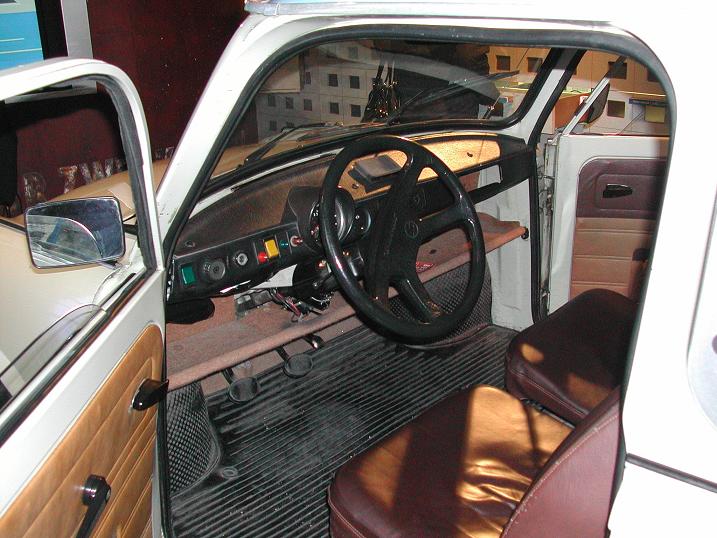 The Trabant had a steel unibody frame, with the roof, boot lid, bonnet, wings and doors made of duroplast, a hard plastic made from recycled cotton waste from the Soviet Union and phenol resins from the East German dye industry. It was the second car with a body made of recycled material; the first was the AWZ P70 Zwickau, produced from 1955 to 1959. The material was durable, and the average lifespan of a Trabant was 28 years.
The Trabant's build quality was poor, reliability was terrible, and it was loud, slow, and poorly designed.
The car had four principal variants:
*The Trabant P 50, also known as the Trabant 500 (produced 1957–1962)
*The Trabant 600 (1962–1965)
*The Trabant 601 (1964–1990)
*The Trabant 1.1, produced in 1990–1991 with a VW engine
The Trabant had a steel unibody frame, with the roof, boot lid, bonnet, wings and doors made of duroplast, a hard plastic made from recycled cotton waste from the Soviet Union and phenol resins from the East German dye industry. It was the second car with a body made of recycled material; the first was the AWZ P70 Zwickau, produced from 1955 to 1959. The material was durable, and the average lifespan of a Trabant was 28 years.
The Trabant's build quality was poor, reliability was terrible, and it was loud, slow, and poorly designed.
The car had four principal variants:
*The Trabant P 50, also known as the Trabant 500 (produced 1957–1962)
*The Trabant 600 (1962–1965)
*The Trabant 601 (1964–1990)
*The Trabant 1.1, produced in 1990–1991 with a VW engine
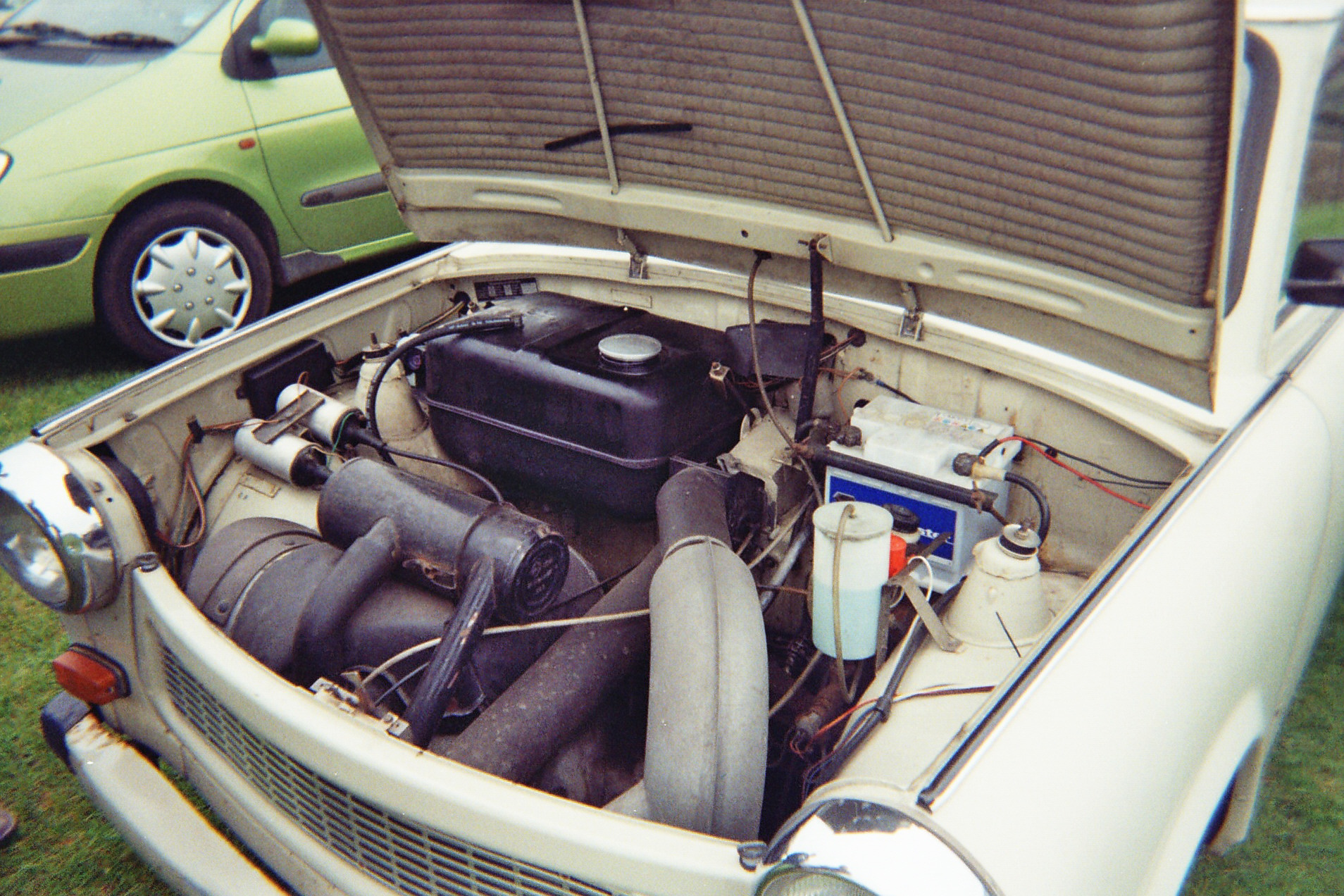 The engine for the 500, 600 and the original 601 was a small two-stroke engine with two cylinders, accounting for the vehicle's modest performance. Its curb weight was about . When it ceased production in 1989, the Trabant delivered from displacement. It took 21 seconds to accelerate from zero to its top speed of .
The engine produced a very smoky exhaust and was a significant source of air pollution: nine times the hydrocarbons and five times the carbon-monoxide emissions of the average 2007 European car. Its fuel consumption was . Since the engine was two-stroke, oil had to be added to the fuel tank at a 50:1 (or 33:1) ratio of fuel to oil at each fill-up. Contemporary gas stations in countries where two-stroke engines were common sold a premixed gas-oil mixture at the pump. Because the Trabant had no fuel pump, its fuel tank was above the motor so fuel could reach the carburettor by gravity; this increased the risk of fire in front-end accidents. Earlier models had no fuel gauge, and a dipstick was inserted into the tank to determine how much fuel remained.
Known for its dull colour scheme and cramped, uncomfortable ride, the Trabant is an object of ridicule for many Germans and is regarded as symbolic of the fall of the
The engine for the 500, 600 and the original 601 was a small two-stroke engine with two cylinders, accounting for the vehicle's modest performance. Its curb weight was about . When it ceased production in 1989, the Trabant delivered from displacement. It took 21 seconds to accelerate from zero to its top speed of .
The engine produced a very smoky exhaust and was a significant source of air pollution: nine times the hydrocarbons and five times the carbon-monoxide emissions of the average 2007 European car. Its fuel consumption was . Since the engine was two-stroke, oil had to be added to the fuel tank at a 50:1 (or 33:1) ratio of fuel to oil at each fill-up. Contemporary gas stations in countries where two-stroke engines were common sold a premixed gas-oil mixture at the pump. Because the Trabant had no fuel pump, its fuel tank was above the motor so fuel could reach the carburettor by gravity; this increased the risk of fire in front-end accidents. Earlier models had no fuel gauge, and a dipstick was inserted into the tank to determine how much fuel remained.
Known for its dull colour scheme and cramped, uncomfortable ride, the Trabant is an object of ridicule for many Germans and is regarded as symbolic of the fall of the
 The first of the Trabants left the VEB Sachsenring Automobilwerke Zwickau factory in Saxony on 7 November 1957. It was a relatively advanced car when it was formally introduced the following year, with front wheel drive,
The first of the Trabants left the VEB Sachsenring Automobilwerke Zwickau factory in Saxony on 7 November 1957. It was a relatively advanced car when it was formally introduced the following year, with front wheel drive, 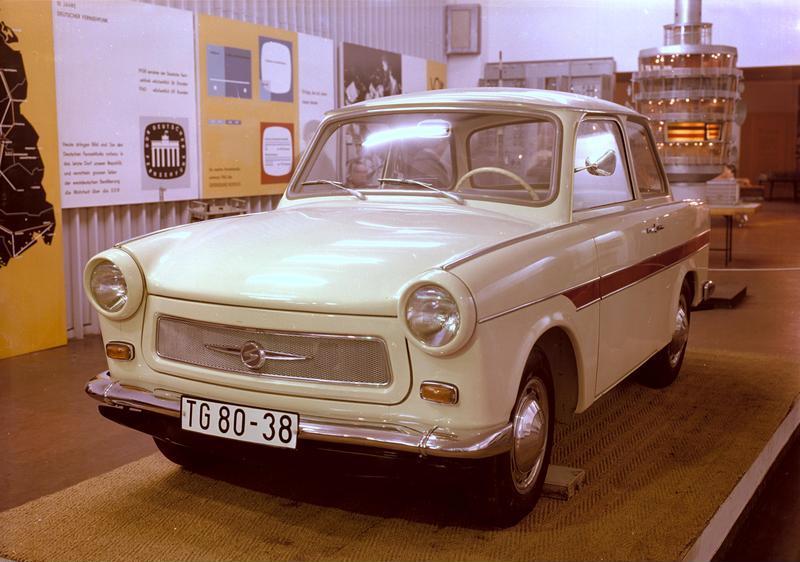 The updated P601 was introduced in 1964. It was essentially a facelift of the P 60, with a different front fascia, bonnet, roof and rear and the original P50 underpinnings. The model remained nearly unchanged until the end of its production except for the addition of 12V electricity, rear coil springs and an updated dashboard for later models.
The updated P601 was introduced in 1964. It was essentially a facelift of the P 60, with a different front fascia, bonnet, roof and rear and the original P50 underpinnings. The model remained nearly unchanged until the end of its production except for the addition of 12V electricity, rear coil springs and an updated dashboard for later models.
 The Trabant's designers expected production to extend until 1967 at the latest, and East German designers and engineers created a series of more-sophisticated prototypes intended to replace the P601; several are displayed at the Dresden Transport Museum. Each proposal for a new model was rejected by the East German government due to shortages of the raw materials required in larger quantities for the more-advanced designs. As a result, the Trabant remained largely unchanged for more than a quarter-century. Also unchanged was its production method, which was extremely labour-intensive.
Production started from 34,000 p.a. in 1964, reached 100,000 p.a. in 1973, to a high of 150,000 in 1989.
The Trabant 1.1 was a 601 with a better-performing 1.05-liter (), VW Polo engine. With a slightly modified look (including a floor-mounted gearshift), it was quieter and cleaner than its predecessor. The 1.1 had front disc brakes, and its wheel assembly was borrowed from Volkswagen. It was produced from 1989 to 1991, in parallel with the two-stroke P601. Except for the engine and transmission, many parts from older P50s, P60s and 601s were compatible with the 1.1.
The Trabant's designers expected production to extend until 1967 at the latest, and East German designers and engineers created a series of more-sophisticated prototypes intended to replace the P601; several are displayed at the Dresden Transport Museum. Each proposal for a new model was rejected by the East German government due to shortages of the raw materials required in larger quantities for the more-advanced designs. As a result, the Trabant remained largely unchanged for more than a quarter-century. Also unchanged was its production method, which was extremely labour-intensive.
Production started from 34,000 p.a. in 1964, reached 100,000 p.a. in 1973, to a high of 150,000 in 1989.
The Trabant 1.1 was a 601 with a better-performing 1.05-liter (), VW Polo engine. With a slightly modified look (including a floor-mounted gearshift), it was quieter and cleaner than its predecessor. The 1.1 had front disc brakes, and its wheel assembly was borrowed from Volkswagen. It was produced from 1989 to 1991, in parallel with the two-stroke P601. Except for the engine and transmission, many parts from older P50s, P60s and 601s were compatible with the 1.1.
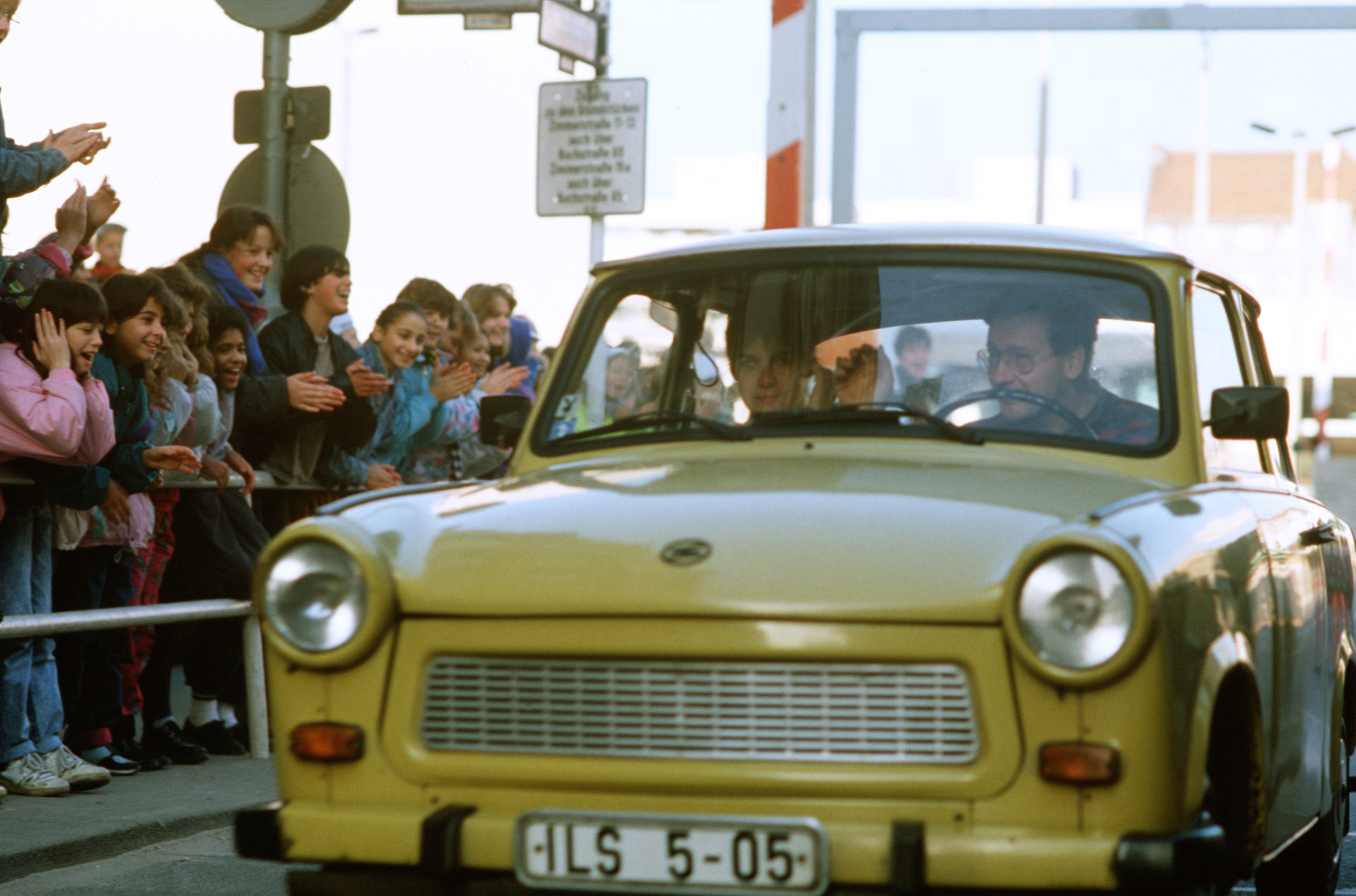
 In mid-1989, thousands of East Germans began loading their Trabants with as much as they could carry and drove to Hungary or Czechoslovakia en route to West Germany–the so-called "Trabi Trail". Many had to get special permission to drive their Trabants into West Germany. The cars did not meet West German emissions standards and polluted the air at four times the European average.
A licensed version of the Volkswagen Polo engine replaced the Trabant's two-stroke engine, the result of a trade agreement between East and West Germany. The first prototypes were built in 1988, with pre-series cars appearing in 1989, but series production only began in May 1990 - By which time the two German states had already agreed to reunification. The locally built EA111-series engine was given the model code BM 820 by the East Germans; the plant also made 1.3-liter versions for the Wartburg 1.3 (BM 860) and the Barkas utility vehicle (BM 880). The model, the Trabant 1.1, also had minor improvements to its brake and signal lights, a renovated grille, and MacPherson struts instead of a leaf-spring-suspended chassis.
By April 1991, after only eleven months, the Trabant 1.1 was discontinued. In total, 3.7 million Trabant vehicles had been produced. However, it soon became apparent that there was no place for the Trabant in a reunified German economy. Its inefficient, labour-intensive production line had only survived thanks to government subsidies.
The Zwickau factory in Mosel (where the Trabant was manufactured) was sold to Volkswagen AG; the rest of the company became HQM Sachsenring GmbH. Volkswagen redeveloped the Zwickau factory into a centre for engine production; it also produces some Volkswagen Golfs and Passats.
In mid-1989, thousands of East Germans began loading their Trabants with as much as they could carry and drove to Hungary or Czechoslovakia en route to West Germany–the so-called "Trabi Trail". Many had to get special permission to drive their Trabants into West Germany. The cars did not meet West German emissions standards and polluted the air at four times the European average.
A licensed version of the Volkswagen Polo engine replaced the Trabant's two-stroke engine, the result of a trade agreement between East and West Germany. The first prototypes were built in 1988, with pre-series cars appearing in 1989, but series production only began in May 1990 - By which time the two German states had already agreed to reunification. The locally built EA111-series engine was given the model code BM 820 by the East Germans; the plant also made 1.3-liter versions for the Wartburg 1.3 (BM 860) and the Barkas utility vehicle (BM 880). The model, the Trabant 1.1, also had minor improvements to its brake and signal lights, a renovated grille, and MacPherson struts instead of a leaf-spring-suspended chassis.
By April 1991, after only eleven months, the Trabant 1.1 was discontinued. In total, 3.7 million Trabant vehicles had been produced. However, it soon became apparent that there was no place for the Trabant in a reunified German economy. Its inefficient, labour-intensive production line had only survived thanks to government subsidies.
The Zwickau factory in Mosel (where the Trabant was manufactured) was sold to Volkswagen AG; the rest of the company became HQM Sachsenring GmbH. Volkswagen redeveloped the Zwickau factory into a centre for engine production; it also produces some Volkswagen Golfs and Passats.
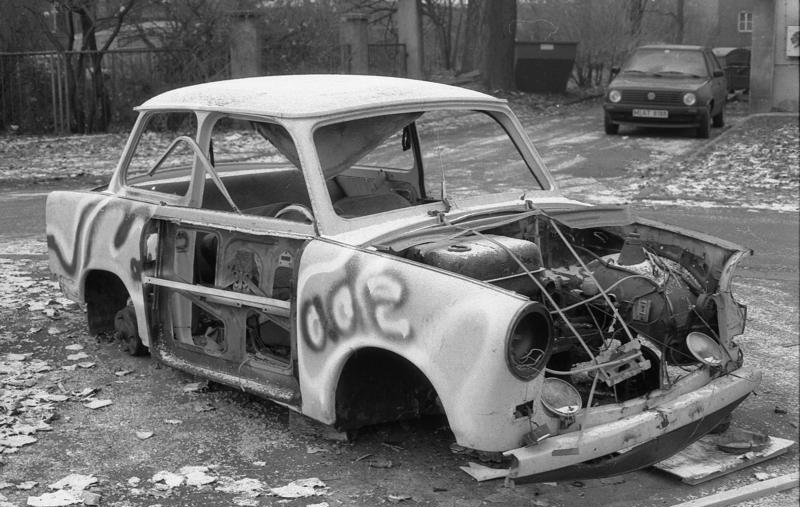
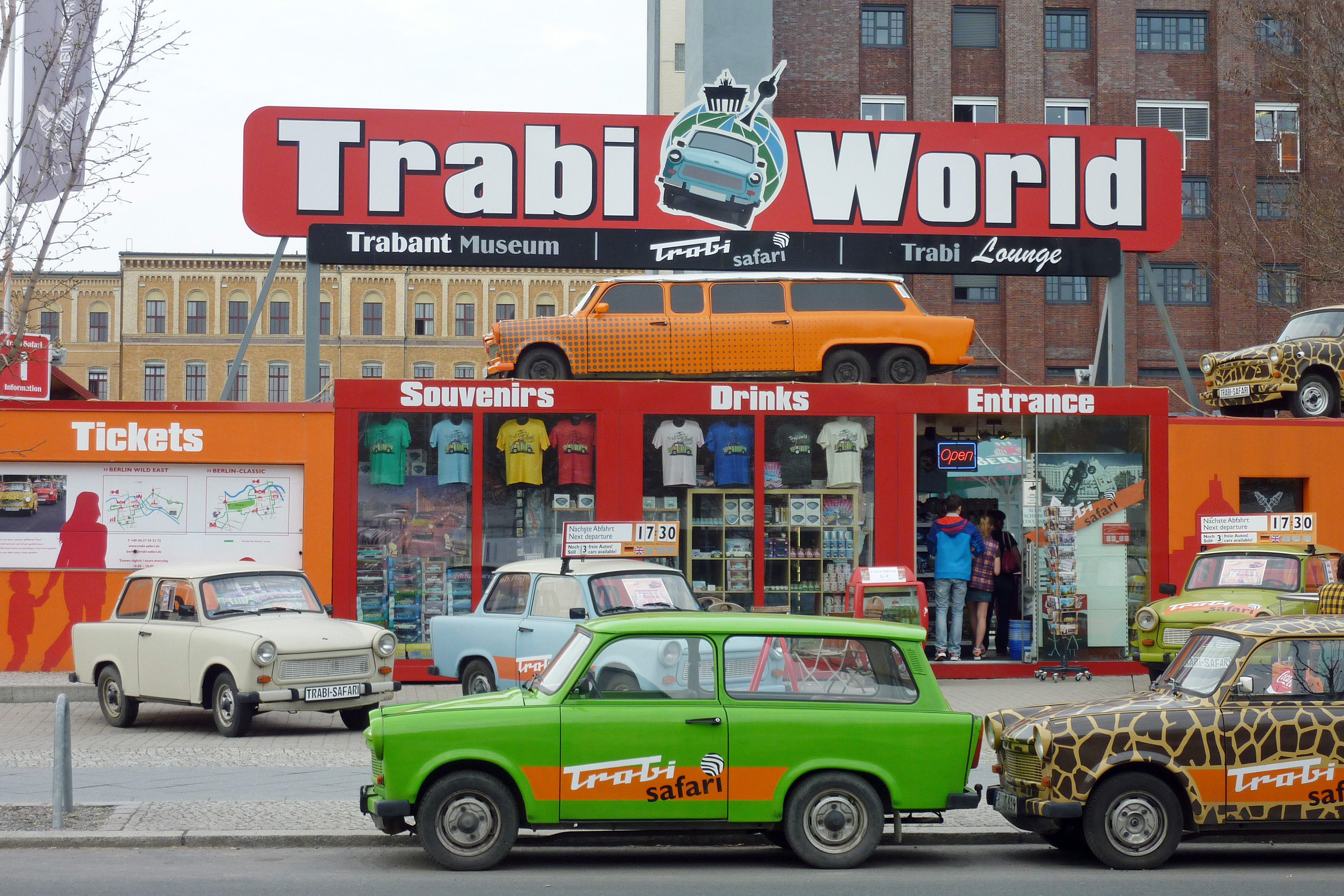 According to Richard Leiby, the Trabant had become "a symbol of the technological and social backwardness of the East German state." Trabants became a symbol of the GDR's serious flaws in the West after the fall of the
According to Richard Leiby, the Trabant had become "a symbol of the technological and social backwardness of the East German state." Trabants became a symbol of the GDR's serious flaws in the West after the fall of the  Former Bulgarian
Former Bulgarian

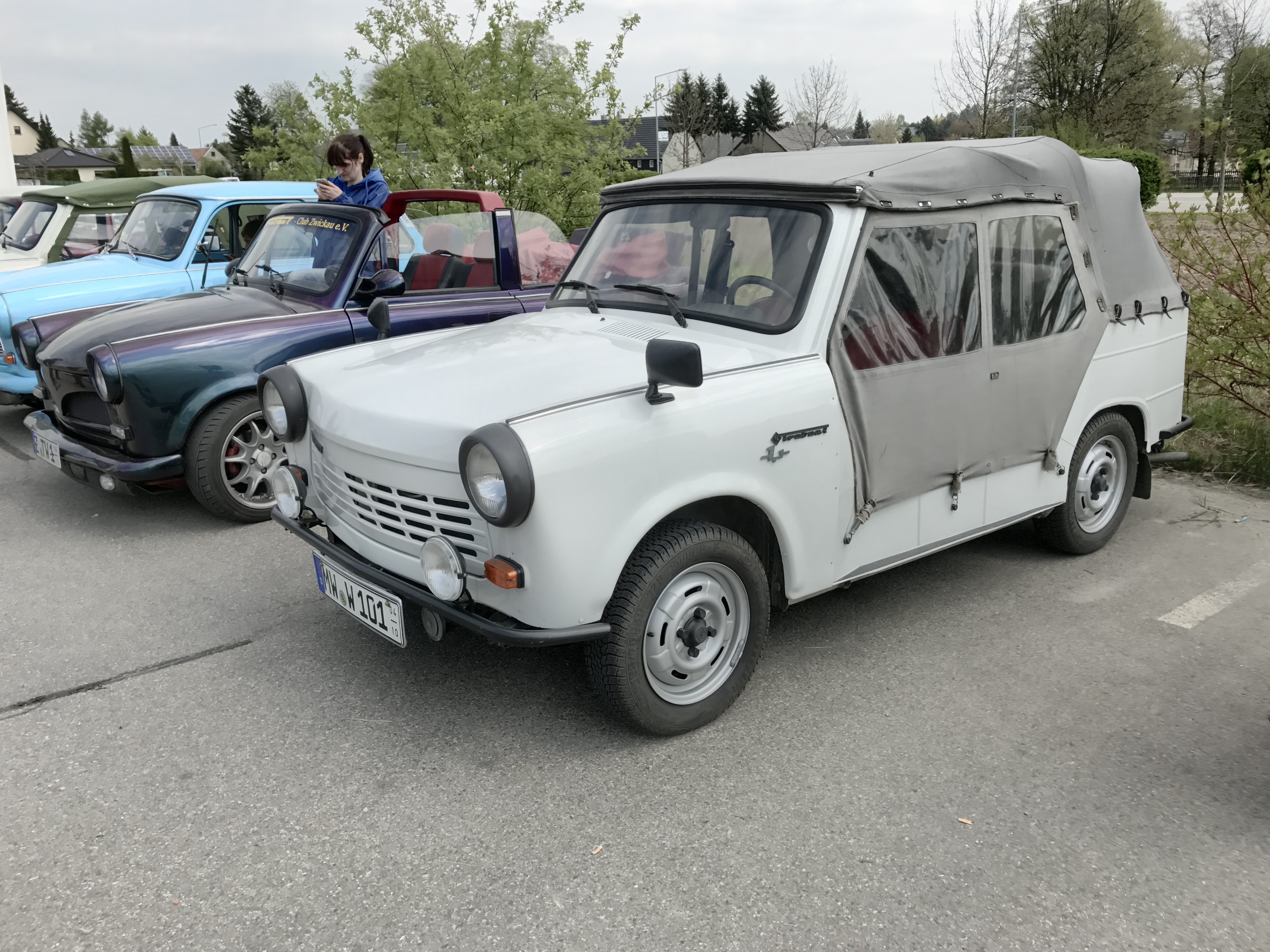 * P50: Later known as the 500 (Limousine and Universal ombi
* 600 (Limousine and Universal)
* 601 Standard (Limousine, Universal)
** 601S (''Sonderwunsch''; Special Edition) with fog lamps, a rear white light and an odometer
** 601 DeLuxe: Similar to the 601S, with two colours and a chrome bumper
** 601 Kübel: Doorless jeep with a folding roof, auxiliary heating system and RFI-shielded ignition
** 601 Tramp: Civilian version of the Kübel, primarily exported to Greece
** 601 Hycomat: For drivers unable to use their left leg, with an automatic clutch
** 800RS: Rally version
* 1.1: Limousine, Universal and Tramp ( convertible)
* P50: Later known as the 500 (Limousine and Universal ombi
* 600 (Limousine and Universal)
* 601 Standard (Limousine, Universal)
** 601S (''Sonderwunsch''; Special Edition) with fog lamps, a rear white light and an odometer
** 601 DeLuxe: Similar to the 601S, with two colours and a chrome bumper
** 601 Kübel: Doorless jeep with a folding roof, auxiliary heating system and RFI-shielded ignition
** 601 Tramp: Civilian version of the Kübel, primarily exported to Greece
** 601 Hycomat: For drivers unable to use their left leg, with an automatic clutch
** 800RS: Rally version
* 1.1: Limousine, Universal and Tramp ( convertible)
P 50.jpg, Trabant P 50
P 1.1 Trabant Kubelwagen.jpg, Trabant P 1.1 Kubelwagen
P 601 Trabant WE II - front.jpg, Trabant P 601 WE II
Trabant500Pickup.jpg, Trabant 500 Pickup
Trabant P50 Kombi vr bicolor TCE.jpg, Trabant P 50 Kombi
File:DSCF0008trabant.JPG, alt=Yellow station wagon with advertising, A "billboard on wheels" in Prague
File:Trabant Feuerwehrversion.jpg, alt=Red-and-white station wagon, Outfitted for volunteer firefighting
File:Trabant Polizeiversion.jpg, alt=Green-and-white police car, Police car used for public relations in
online
* Rubin, Eli. "The Trabant: Consumption, Eigen-Sinn, and Movement." ''History Workshop Journal'' (2009) 68#1 pp 27–44
online
* Zatlin, Jonathan R. "The vehicle of desire: The Trabant, the Wartburg, and the end of the GDR." ''German History'' 15.3 (1997): 358–380
online
* * * *
UK-based official Wartburg, Trabant and IFA owners' club
*
TrabantForums
TrabantForums.com
The story behind Trabant
IFA Mobile 2-takt Vereniging, de oudste vereniging voor Oost-Duitse auto's
Trabant history and prospects
Technical Data and additional Information about Trabant 601.
British microcar club that welcomes trabant owners and drivers
;Media
Interactive presentation of Red Pearl Trabant 601z
Trabant TV ad
at Google Videos
Trabant test drive
at Google Videos * {{Authority control 1960s cars 1970s cars 1980s cars 1990s cars Cars introduced in 1957 Front-wheel-drive vehicles Ostalgie Sachsenring vehicles 1957 establishments in East Germany
Trabant 500
The Trabant P 50 (), also known as the Trabant 500, is the first series production model of the East German Trabant series, made by VEB Sachsenring Automobilwerke Zwickau. It was produced from 1957 until 1962; in total, 131,495 units were built (i ...
, Trabant 600, Trabant 601, and the Trabant 1.1. The first Trabant model, the Trabant 500, was a modern car when it was introduced in 1957. It featured a duroplast body mounted on a one-piece steel chassis (a so-called unibody), front-wheel drive, a transverse two-stroke engine, and independent suspension. Because this 1950s design remained largely unchanged until the introduction of the last Trabant model, the Trabant 1.1 in 1990, the Trabant became symbolic of the former East Germany's stagnant economy and the collapse of the Eastern Bloc
The Eastern Bloc, also known as the Communist Bloc and the Soviet Bloc, was the group of socialist states of Central and Eastern Europe, East Asia, Southeast Asia, Africa, and Latin America under the influence of the Soviet Union that existed du ...
in general. Called "a spark plug with a roof", 3,096,999 Trabants were produced. Older models have been sought by collectors in the United States due to their low cost and fewer restrictions on the importation of antique cars. The Trabant also gained a following among car tuning and rally racing
Rally or rallye may refer to:
Gatherings
* Demonstration (political), a political rally, a political demonstration of support or protest, march, or parade
* Pep rally
A pep rally or pep assembly is a gathering of people, typically students ...
enthusiasts.
Overview
 The German word ''Trabant'', derived from the Middle High German ''drabant'', means "satellite" or "companion". The car's name was inspired by the Soviet
The German word ''Trabant'', derived from the Middle High German ''drabant'', means "satellite" or "companion". The car's name was inspired by the Soviet Sputnik
Sputnik 1 (; see § Etymology) was the first artificial Earth satellite. It was launched into an elliptical low Earth orbit by the Soviet Union on 4 October 1957 as part of the Soviet space program. It sent a radio signal back to Earth for t ...
satellite. The cars are often referred to as "Trabbi" or "Trabi". Produced without major changes for nearly 30 years, the Trabant became the most common automobile in East Germany. It came to symbolize the country during the fall of the Berlin Wall in 1989, as images of East Germans crossing the border into West Germany were broadcast around the globe.
Since its manufacturer was a state monopoly, acquiring a Trabant took about ten years. East German buyers were placed on a waiting-list of up to thirteen years. The waiting time depended on their proximity to Berlin, the capital. Official state price was 7,450 GDR marks and the demand to production ratio was forty three to one (1989). The free market price for a second-hand one was more than twice the price of a new one, and the average worker had to wait ten to thirteen years on a waiting list, or, if available, pay more than double for a second hand model.
 The engine for the 500, 600 and the original 601 was a small two-stroke engine with two cylinders, accounting for the vehicle's modest performance. Its curb weight was about . When it ceased production in 1989, the Trabant delivered from displacement. It took 21 seconds to accelerate from zero to its top speed of .
The engine produced a very smoky exhaust and was a significant source of air pollution: nine times the hydrocarbons and five times the carbon-monoxide emissions of the average 2007 European car. Its fuel consumption was . Since the engine was two-stroke, oil had to be added to the fuel tank at a 50:1 (or 33:1) ratio of fuel to oil at each fill-up. Contemporary gas stations in countries where two-stroke engines were common sold a premixed gas-oil mixture at the pump. Because the Trabant had no fuel pump, its fuel tank was above the motor so fuel could reach the carburettor by gravity; this increased the risk of fire in front-end accidents. Earlier models had no fuel gauge, and a dipstick was inserted into the tank to determine how much fuel remained.
Known for its dull colour scheme and cramped, uncomfortable ride, the Trabant is an object of ridicule for many Germans and is regarded as symbolic of the fall of the
The engine for the 500, 600 and the original 601 was a small two-stroke engine with two cylinders, accounting for the vehicle's modest performance. Its curb weight was about . When it ceased production in 1989, the Trabant delivered from displacement. It took 21 seconds to accelerate from zero to its top speed of .
The engine produced a very smoky exhaust and was a significant source of air pollution: nine times the hydrocarbons and five times the carbon-monoxide emissions of the average 2007 European car. Its fuel consumption was . Since the engine was two-stroke, oil had to be added to the fuel tank at a 50:1 (or 33:1) ratio of fuel to oil at each fill-up. Contemporary gas stations in countries where two-stroke engines were common sold a premixed gas-oil mixture at the pump. Because the Trabant had no fuel pump, its fuel tank was above the motor so fuel could reach the carburettor by gravity; this increased the risk of fire in front-end accidents. Earlier models had no fuel gauge, and a dipstick was inserted into the tank to determine how much fuel remained.
Known for its dull colour scheme and cramped, uncomfortable ride, the Trabant is an object of ridicule for many Germans and is regarded as symbolic of the fall of the Eastern Bloc
The Eastern Bloc, also known as the Communist Bloc and the Soviet Bloc, was the group of socialist states of Central and Eastern Europe, East Asia, Southeast Asia, Africa, and Latin America under the influence of the Soviet Union that existed du ...
. Known as a "spark plug with a roof" because of its small size, the car did gain public affection.
Its design remained essentially unchanged from its introduction in the late 1950s, and the last model was introduced in 1990, the 1980s model had no tachometer, no indicator for either the headlights or turn signals, no fuel gauge, no rear seat belts, no external fuel door, and drivers had to pour a mix of gasoline and oil directly under the bonnet/hood. In contrast, the West German Volkswagen Beetle received a number of updates (including improvements in efficiency) over a similar period.
History
Origins
VEB Sachsenring Automobilwerke Zwickau had its origins in the former Auto Union/DKW
DKW (''Dampf-Kraft-Wagen'', en, "steam-powered car", also ''Deutsche Kinder-Wagen'' en, "German children's car". ''Das-Kleine-Wunder'', en, "the little wonder" or ''Des-Knaben-Wunsch'', en, "the boy's wish"- from when the company built to ...
business which has operated out of the site prior to the war, and the company's first products were essentially copies of pre-war DKW designs. Following the partition of Germany, Auto Union re-established itself in West Germany (ultimately evolving into Audi), leaving VEB Sachsenring with the two stroke engine inherited from DKW.
The Trabant was the result of a planning process which had been intended to design a three-wheeled motorcycle. In German, ''Trabant'' is an astronomical term for a moon (or other natural satellite) of a celestial body.
Full production
 The first of the Trabants left the VEB Sachsenring Automobilwerke Zwickau factory in Saxony on 7 November 1957. It was a relatively advanced car when it was formally introduced the following year, with front wheel drive,
The first of the Trabants left the VEB Sachsenring Automobilwerke Zwickau factory in Saxony on 7 November 1957. It was a relatively advanced car when it was formally introduced the following year, with front wheel drive, unitary construction
A vehicle frame, also historically known as its ''chassis'', is the main supporting structure of a motor vehicle to which all other components are attached, comparable to the skeleton of an organism.
Until the 1930s, virtually every car had a ...
and independent suspension. The Trabant's greatest shortcoming was its engine. By the late 1950s, many small West European cars (such as the Renault) had cleaner, more-efficient four-stroke
A four-stroke (also four-cycle) engine is an internal combustion (IC) engine in which the piston completes four separate strokes while turning the crankshaft. A stroke refers to the full travel of the piston along the cylinder, in either directio ...
engines, but budgetary constraints and raw-materials shortages mandated an outdated (but inexpensive) two-stroke engine in the Trabant. It was technically equivalent to the West German Lloyd
Lloyd, Lloyd's, or Lloyds may refer to:
People
* Lloyd (name), a variation of the Welsh word ' or ', which means "grey" or "brown"
** List of people with given name Lloyd
** List of people with surname Lloyd
* Lloyd (singer) (born 1986), American ...
automobile, a similarly sized car with an air-cooled, two-cylinder four-stroke engine. The Trabant had a front, transversely mounted engine and front-wheel drive in an era when many European cars were using rear-mounted engines or front-mounted engines with rear-wheel drive. Its greatest drawback was its largely unchanged production; the car's two-stroke engine made it obsolete by the 1970s, limiting exports to Western Europe.
The Trabant's air-cooled, engine—upgraded to in 1962–63—was derived from a pre-war DKW
DKW (''Dampf-Kraft-Wagen'', en, "steam-powered car", also ''Deutsche Kinder-Wagen'' en, "German children's car". ''Das-Kleine-Wunder'', en, "the little wonder" or ''Des-Knaben-Wunsch'', en, "the boy's wish"- from when the company built to ...
design with minor alterations during its production run. The first Saab car had a larger (764 cc), water-cooled, two-cylinder two-stroke engine. Wartburg, an East German manufacturer of larger sedans, also used a water-cooled, three-cylinder, , two-stroke DKW engine.
The original Trabant, introduced in 1958, was the P 50. Trabant's base model, it shared a large number of interchangeable parts with the latest 1.1s. The 500 cc, P50 evolved into a version with a fully synchronized gearbox in 1960, and received a , engine in 1962 as the P 60.
 The updated P601 was introduced in 1964. It was essentially a facelift of the P 60, with a different front fascia, bonnet, roof and rear and the original P50 underpinnings. The model remained nearly unchanged until the end of its production except for the addition of 12V electricity, rear coil springs and an updated dashboard for later models.
The updated P601 was introduced in 1964. It was essentially a facelift of the P 60, with a different front fascia, bonnet, roof and rear and the original P50 underpinnings. The model remained nearly unchanged until the end of its production except for the addition of 12V electricity, rear coil springs and an updated dashboard for later models.
 The Trabant's designers expected production to extend until 1967 at the latest, and East German designers and engineers created a series of more-sophisticated prototypes intended to replace the P601; several are displayed at the Dresden Transport Museum. Each proposal for a new model was rejected by the East German government due to shortages of the raw materials required in larger quantities for the more-advanced designs. As a result, the Trabant remained largely unchanged for more than a quarter-century. Also unchanged was its production method, which was extremely labour-intensive.
Production started from 34,000 p.a. in 1964, reached 100,000 p.a. in 1973, to a high of 150,000 in 1989.
The Trabant 1.1 was a 601 with a better-performing 1.05-liter (), VW Polo engine. With a slightly modified look (including a floor-mounted gearshift), it was quieter and cleaner than its predecessor. The 1.1 had front disc brakes, and its wheel assembly was borrowed from Volkswagen. It was produced from 1989 to 1991, in parallel with the two-stroke P601. Except for the engine and transmission, many parts from older P50s, P60s and 601s were compatible with the 1.1.
The Trabant's designers expected production to extend until 1967 at the latest, and East German designers and engineers created a series of more-sophisticated prototypes intended to replace the P601; several are displayed at the Dresden Transport Museum. Each proposal for a new model was rejected by the East German government due to shortages of the raw materials required in larger quantities for the more-advanced designs. As a result, the Trabant remained largely unchanged for more than a quarter-century. Also unchanged was its production method, which was extremely labour-intensive.
Production started from 34,000 p.a. in 1964, reached 100,000 p.a. in 1973, to a high of 150,000 in 1989.
The Trabant 1.1 was a 601 with a better-performing 1.05-liter (), VW Polo engine. With a slightly modified look (including a floor-mounted gearshift), it was quieter and cleaner than its predecessor. The 1.1 had front disc brakes, and its wheel assembly was borrowed from Volkswagen. It was produced from 1989 to 1991, in parallel with the two-stroke P601. Except for the engine and transmission, many parts from older P50s, P60s and 601s were compatible with the 1.1.
1989–1991
 In mid-1989, thousands of East Germans began loading their Trabants with as much as they could carry and drove to Hungary or Czechoslovakia en route to West Germany–the so-called "Trabi Trail". Many had to get special permission to drive their Trabants into West Germany. The cars did not meet West German emissions standards and polluted the air at four times the European average.
A licensed version of the Volkswagen Polo engine replaced the Trabant's two-stroke engine, the result of a trade agreement between East and West Germany. The first prototypes were built in 1988, with pre-series cars appearing in 1989, but series production only began in May 1990 - By which time the two German states had already agreed to reunification. The locally built EA111-series engine was given the model code BM 820 by the East Germans; the plant also made 1.3-liter versions for the Wartburg 1.3 (BM 860) and the Barkas utility vehicle (BM 880). The model, the Trabant 1.1, also had minor improvements to its brake and signal lights, a renovated grille, and MacPherson struts instead of a leaf-spring-suspended chassis.
By April 1991, after only eleven months, the Trabant 1.1 was discontinued. In total, 3.7 million Trabant vehicles had been produced. However, it soon became apparent that there was no place for the Trabant in a reunified German economy. Its inefficient, labour-intensive production line had only survived thanks to government subsidies.
The Zwickau factory in Mosel (where the Trabant was manufactured) was sold to Volkswagen AG; the rest of the company became HQM Sachsenring GmbH. Volkswagen redeveloped the Zwickau factory into a centre for engine production; it also produces some Volkswagen Golfs and Passats.
In mid-1989, thousands of East Germans began loading their Trabants with as much as they could carry and drove to Hungary or Czechoslovakia en route to West Germany–the so-called "Trabi Trail". Many had to get special permission to drive their Trabants into West Germany. The cars did not meet West German emissions standards and polluted the air at four times the European average.
A licensed version of the Volkswagen Polo engine replaced the Trabant's two-stroke engine, the result of a trade agreement between East and West Germany. The first prototypes were built in 1988, with pre-series cars appearing in 1989, but series production only began in May 1990 - By which time the two German states had already agreed to reunification. The locally built EA111-series engine was given the model code BM 820 by the East Germans; the plant also made 1.3-liter versions for the Wartburg 1.3 (BM 860) and the Barkas utility vehicle (BM 880). The model, the Trabant 1.1, also had minor improvements to its brake and signal lights, a renovated grille, and MacPherson struts instead of a leaf-spring-suspended chassis.
By April 1991, after only eleven months, the Trabant 1.1 was discontinued. In total, 3.7 million Trabant vehicles had been produced. However, it soon became apparent that there was no place for the Trabant in a reunified German economy. Its inefficient, labour-intensive production line had only survived thanks to government subsidies.
The Zwickau factory in Mosel (where the Trabant was manufactured) was sold to Volkswagen AG; the rest of the company became HQM Sachsenring GmbH. Volkswagen redeveloped the Zwickau factory into a centre for engine production; it also produces some Volkswagen Golfs and Passats.
1990s and later

 According to Richard Leiby, the Trabant had become "a symbol of the technological and social backwardness of the East German state." Trabants became a symbol of the GDR's serious flaws in the West after the fall of the
According to Richard Leiby, the Trabant had become "a symbol of the technological and social backwardness of the East German state." Trabants became a symbol of the GDR's serious flaws in the West after the fall of the Berlin Wall
The Berlin Wall (german: Berliner Mauer, ) was a guarded concrete barrier that encircled West Berlin from 1961 to 1989, separating it from East Berlin and East Germany (GDR). Construction of the Berlin Wall was commenced by the government ...
, when many were abandoned by their Eastern owners who migrated west. Unlike the Lada Niva
The Lada Niva Legend, formerly called the Lada Niva, VAZ-2121, VAZ-2131, and Lada 4×4 (russian: link=no, ВАЗ-2121, ВАЗ-2131, Лада Нива), is a series of four-wheel drive, small (hatchback), and compact (wagon and pickup) off-road c ...
, Škoda Estelle, Polski Fiat ( design licensed from the Italian car manufacturer) and Yugo, the Trabant had negligible sales in Western Europe.
A Trabant could be bought for as little as a few Deutsche Marks during the early 1990s, and many were given away. Although prices recovered as they became collectors' items, they remain inexpensive cars. In her ''Bodywork'' project, performance artist Liz Cohen transformed a 1987 Trabant into a 1973 Chevrolet El Camino. The Trabant was planned to return to production in Uzbekistan as the Olimp during the late 1990s, but only one model was produced.
 Former Bulgarian
Former Bulgarian Foreign Minister
A foreign affairs minister or minister of foreign affairs (less commonly minister for foreign affairs) is generally a cabinet minister in charge of a state's foreign policy and relations. The formal title of the top official varies between cou ...
and Atlantic Club of Bulgaria
The Atlantic Club of Bulgaria is a non-governmental, non-partisan organization dedicated to fostering the common values of the Euro-Atlantic community.
History
The Atlantic Club of Bulgaria was created in 1990 around the pro-NATO lobby in the ...
founding president Solomon Passy owned a Trabant which was blessed by Pope John Paul II in 2002 and in which he took NATO Secretaries General Manfred Wörner, George Robertson, and Jaap de Hoop Scheffer for rides. In 2005, Passy donated the vehicle (which had become symbolic of Bulgaria's NATO accession) to the National Historical Museum of Bulgaria. In 1997, the Trabant was celebrated for passing the moose test without rolling over, as the Mercedes-Benz W168 had; a Thuringian newspaper's headline read, "Come and get us, moose! Trabi passes A-Class killer test".
The Trabant entered the world of diplomacy in 2007 when Steven Fisher, deputy head of mission at the British Embassy in Budapest, used a 1.1 (painted as close to British racing green as possible) as his diplomatic car
An official state car is a vehicle used by a government to transport its head of state or head of government in an official capacity, which may also be used occasionally to transport other members of the government or visiting dignitaries from ot ...
. American Trabant owners celebrate the fall of the Berlin Wall with the Parade of Trabants, an annual early-November rally held in Washington, D.C. The event, sponsored by the privately owned International Spy Museum
The International Spy Museum is an independent non-profit museum which documents the tradecraft, history, and contemporary role of espionage. It holds the largest collection of international espionage artifacts on public display. The museum opened ...
, includes street tours in Trabants, rides, live German music and displays about East Germany.
Planned reintroduction
The Herpa company, a Bavarian miniature-vehicle manufacturer, bought the rights to the Trabant name and showed a scale model of a "newTrabi" at the 2007 Frankfurt Motor Show. Plans for production included a limited run, possibly with a BMW engine. A Trabant nT model was unveiled two years later in Frankfurt. The Trabant nTconsortium
A consortium (plural: consortia) is an association of two or more individuals, companies, organizations or governments (or any combination of these entities) with the objective of participating in a common activity or pooling their resources for ...
includes Herpa, the German specialized-auto-parts manufacturer IndiKar and the German automobile-engineering company IAV. The group was looking for investment, design and production in the Trabant's original hometown of Zwickau, with sales "in 2012". The Trabant nT electric car
An electric car, battery electric car, or all-electric car is an automobile that is propelled by one or more electric motors, using only energy stored in batteries. Compared to internal combustion engine (ICE) vehicles, electric cars are quie ...
would be equipped with a asynchronous motor powered by a lithium-ion battery.
Models

 * P50: Later known as the 500 (Limousine and Universal ombi
* 600 (Limousine and Universal)
* 601 Standard (Limousine, Universal)
** 601S (''Sonderwunsch''; Special Edition) with fog lamps, a rear white light and an odometer
** 601 DeLuxe: Similar to the 601S, with two colours and a chrome bumper
** 601 Kübel: Doorless jeep with a folding roof, auxiliary heating system and RFI-shielded ignition
** 601 Tramp: Civilian version of the Kübel, primarily exported to Greece
** 601 Hycomat: For drivers unable to use their left leg, with an automatic clutch
** 800RS: Rally version
* 1.1: Limousine, Universal and Tramp ( convertible)
* P50: Later known as the 500 (Limousine and Universal ombi
* 600 (Limousine and Universal)
* 601 Standard (Limousine, Universal)
** 601S (''Sonderwunsch''; Special Edition) with fog lamps, a rear white light and an odometer
** 601 DeLuxe: Similar to the 601S, with two colours and a chrome bumper
** 601 Kübel: Doorless jeep with a folding roof, auxiliary heating system and RFI-shielded ignition
** 601 Tramp: Civilian version of the Kübel, primarily exported to Greece
** 601 Hycomat: For drivers unable to use their left leg, with an automatic clutch
** 800RS: Rally version
* 1.1: Limousine, Universal and Tramp ( convertible)
Prototype and concepts
Dozens of prototypes have been created over the years that have not gone into mass production. * 1954 Trabant P50 prototype * 1954 Trabant P50 Universal prototype * 1959 Trabant P504 * 1961 Trabant P100 * 1965 Trabant P602V * 1970 Trabant P760 * 1971 Trabant P610 Prototype * 1981 Trabant P601 Z * 1982 Trabant 601 WE II Prototype * 1988 Trabant 1.1 E * 2009 Trabant nT ConceptGallery prototypes
Gallery
Bremen
Bremen (Low German also: ''Breem'' or ''Bräm''), officially the City Municipality of Bremen (german: Stadtgemeinde Bremen, ), is the capital of the German state Free Hanseatic City of Bremen (''Freie Hansestadt Bremen''), a two-city-state consis ...
File:Trans Trabant 2009 6063.JPG, alt=Two yellow cars with their drivers shaking hands, Leaving for a 2009 trip from Prague to Cape Town
File:1,75 Trabi 601 - 1.jpg, alt=Matching station wagon and trailer, 601 with homemade trailer
File:Trabant 600 Kombi hr.jpg, alt=White-and-red station wagon, 600 universal
File:Berlin Wall Trabant grafitti.jpg, alt=See caption, Graffiti of a Trabant driving through the Berlin Wall
File:Trabant601K.jpg, alt=White station wagon, 601S universal, with sliding roof
File:Trabant601.jpg, alt=White sedan, 601 Deluxe limousine
File:Trabant 601 Kübelwagen.JPG, alt=Green jeep, 601 Kübel
File:Trabant 1.1 Universal (02).JPG, alt=White station wagon, 1.1 universal
File:East Berlin Trabant Foursome.png, Trabants in an East Berlin, East Germany parking lot during the freedom summer of 1990 (between the fall of The Wall and German Reunification)
See also
*August Horch Museum Zwickau
The August Horch Museum Zwickau is an automobile museum in Zwickau, Saxony, Germany. Opened in 2004, it covers the history of automobile construction in Zwickau, the home of Horch and Audi prior to World War II, and Trabant during the Cold War-er ...
* Jokes about the Trabant
* List of automobiles known for negative reception
* Ostalgie
* Soybean car
* Yugo
Notes
References
Further reading
* Berdahl, Daphne. "'Go, Trabi, Go!': Reflections on a Car and Its Symbolization over Time." ''Anthropology and Humanism'' 25.2 (2000): 131–141online
* Rubin, Eli. "The Trabant: Consumption, Eigen-Sinn, and Movement." ''History Workshop Journal'' (2009) 68#1 pp 27–44
online
* Zatlin, Jonathan R. "The vehicle of desire: The Trabant, the Wartburg, and the end of the GDR." ''German History'' 15.3 (1997): 358–380
online
* * * *
External links
UK-based official Wartburg, Trabant and IFA owners' club
*
TrabantForums
TrabantForums.com
The story behind Trabant
IFA Mobile 2-takt Vereniging, de oudste vereniging voor Oost-Duitse auto's
Trabant history and prospects
Technical Data and additional Information about Trabant 601.
British microcar club that welcomes trabant owners and drivers
;Media
Interactive presentation of Red Pearl Trabant 601z
Trabant TV ad
at Google Videos
Trabant test drive
at Google Videos * {{Authority control 1960s cars 1970s cars 1980s cars 1990s cars Cars introduced in 1957 Front-wheel-drive vehicles Ostalgie Sachsenring vehicles 1957 establishments in East Germany